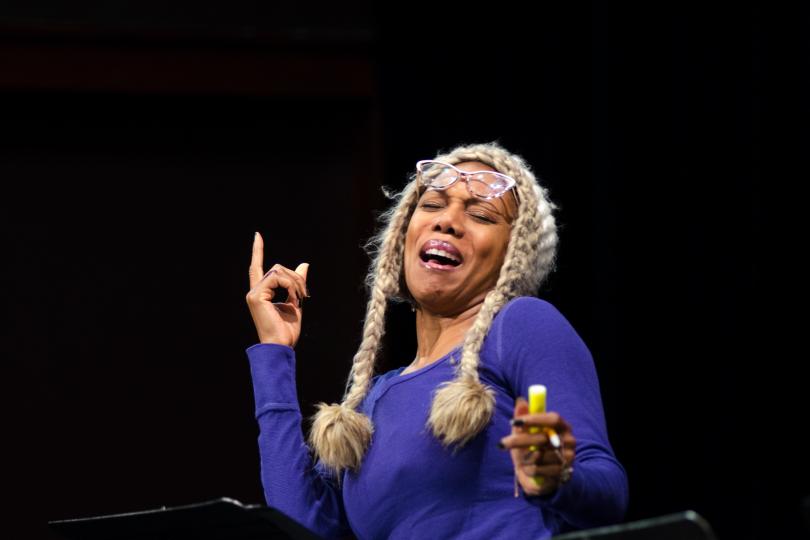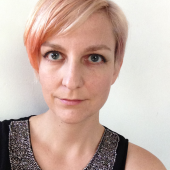Giant Art Heart.

Most days if you walk into the garden level offices of the Playwrights’ Center, you’ll hear footsteps, voices, and laughter sifting down from the theater upstairs. As I write this, Sarah Rasmussen and the Jungle Theater are developing a new play upstairs as part of our Regulars partnership program. Earlier this week, Playwrights’ Center member Philip Michael Hogan traveled to Minneapolis from Shreveport, Louisiana for a professional reading and dramaturgy session of his play Ruby and Blue, featuring actors such as Sue Scott and Terry Bellamy. In the black box theater that used to be the sanctuary of a church, around 70 plays each year find their legs. I wanted to place this article about our public season in that context because I love that the Center’s giant art heart is beating every day, whether there’s a public reading or not.
But let’s talk about our 2017-18 public season! It comprises the PlayLabs festival in October and the Ruth Easton New Play Series from December through April. All 27 of the Playwrights’ Center Core Writers receive development workshops each year; the Core Writers in the public season have expanded workshop time with collaborators and the chance to see their new work on its feet in front of two different audiences. These upsized workshops are especially helpful for formally or aesthetically challenging work that is hard to figure out on a piece of paper. They open up space for experimenting, deep exploration, and what Playwrights’ Center Producing Artistic Director Jeremy Cohen calls “behavioral dramaturgy”—when the playwright can watch the actors behave in space with one another, illuminating subtext that is harder to discern solely on the page.
Bringing in audiences sparks different types of discovery for the playwright. All plays in the public season have two readings. Philip Dawkins (Le Switch, PlayLabs 2014) called the second reading “pretty clutch” and made this comparison: “Only having one reading is like giving a scientist funding to discover a cure for a disease and saying, ‘Now you only get one Petrie dish, and you only get to test out your hypothesis once. If it doesn’t work immediately, too bad so sad.’”
I hope you’ll join us for these readings. In doing so, you’ll be a vital part of the creation story of eight remarkable plays. And they are free! To give you more insight into the plays selected, I talked with Cohen about what interests him about each of this season’s plays:
PlayLabs
A Humbling in St. Paul by Alice Tuan: Commissioned by Yale Repertory Theatre, this play is based on the freak infection Tuan contracted while staying with friends in the Twin Cities last year. Cohen loves its examination of the guest/host space, finding in that space a bigger metaphor for our country and especially for Minnesota, where there is great complexity under the surface of our self-identified welcoming culture. Tuan says, “Writing this play saved me,” because it helped her “process a near-death space and understand the windfalls and psychic strength culled from committing to a playwright life.” October 23 and 27 at 7 p.m.
Take Care by Jason Gray Platt: “Jason writes really epic plays,” Cohen says. “And that doesn’t necessarily mean they’re long or have 15 characters, but he is never after something tiny.” In Take Care, a woman gathers her family to talk about an end-of-life decision. But the play keeps restarting, and every time it restarts, one of the characters has disappeared. Lines are missing, reassigned, or rearranged, meaning a character we thought we knew may take on the language of another character. Cohen says the “glacial shifting” happening in the personal relationships also serves as an ecological allegory, with Jason investigating how the progression and repetition of scenes correlates to pro/regression cycles of Earth. October 24 at 7 p.m. and October 28 at 1 p.m.
In the Time of the Volcano by Jen Silverman: Silverman is shaping an early draft of a play commissioned by South Coast Rep. She became fascinated with the true story of a cargo cult on Vanuatu that worships a man named John Frum, based on contact with an American soldier stationed briefly overseas. What would it be like to learn you were worshipped as a god somewhere across the globe? And the true playwright’s thought: Who would be the most interesting person for that to happen to? For Silverman, that person is an older white man in a small town who feels he is being disenfranchised by people who do not look like him. The play addresses white male supremacy and in particular fear of replacement. October 25 and 28 at 7 p.m.
Ruth Easton New Play Series
The Overcoat: a musical for non musical people by Kira Obolensky: “In this play, Kira doesn’t want to force people to sing in the streets in the way a traditional musical might,” says Cohen. But the music plays a significantly dramatic role, which Cohen says he finds haunting. The play is a re-imagining of Gogol’s short story “The Overcoat” and is intended for a variety of voices, trained or untrained, with simple piano settings. Obolensky collaborates with composer Brian Harnetty on the development of the piece. December 4 and 5 at 7 p.m.
How The Ghost Of You Clings, The Anna May Wong Story by John Olive: Anna May Wong was an incredibly prolific actor, yet she is “utterly forgotten, while many white actors from the same time period are still remembered vividly,” says Cohen. He says Olive’s beautiful and revealing play highlights how far we haven’t come in terms of recognition of Asian and Asian-American actors. Olive says he was chagrined to discover how few people had heard of Anna May Wong and that “this lack of familiarity with a great American is something I hope to rectify with this play.” January 8 and 9 at 7 p.m.
Three Quarter Inches of Sky by Sherry Kramer: Kramer workshopped this play at the Playwrights’ Center last year as well, before taking it down to Austin for a workshop as part of her residency with Rude Mechs. Kramer deeply connected with the actress and director she worked with there, and they are both coming to the Playwrights’ Center to collaborate with Sherry again. “It’s a two-character play, which is so intimate,” says Cohen. “Continuing a good collaboration with a director and actress can be major.” Cohen calls it a simple and heartbreaking play, an end-of-life story that eschews the “big questions” and instead presents a beautiful theatrical meditation. Kramer has been a writer affiliated with the Center for decades and we’re delighted to have her back for this public moment. February 5 and 6 at 7 p.m.
Tiny Houses by Stefanie Zadravec: Zadravec says, “The question I began with for this play was how individuals cope or activate in an increasingly chaotic political world.” Its precipitating event is the downing of Malaysia Airlines Flight MH-17 over Eastern Ukraine in 2014. Cohen says, “I am drawn to the indomitability of women and plays where there is a large cast of actresses on stage. I love the intergenerationality of this piece, too.” Cohen says Zadravec does a very visceral thing by creating a world that feels like it’s 25 or 30 years ago and making the audience realize “but, of course, no, that’s right now.” March 5 and 6 at 7 p.m.
the bandaged place by Harrison David Rivers: Cohen says playwrights often have that one play they need to write but it’s so personal that finding their way to it is difficult. This deeply personal play digs into the complexity of relationships and how any of us move forward from the darkest moments of our lives. Cohen loves that it challenges the Western mentality that dictates what grief “should be like.” April 9 and 10 at 7 p.m.
Learn more about the 2017-18 season here and sign up for our newsletter to be notified when registration opens for each play. I hope to see you at the Playwrights’ Center this season.




